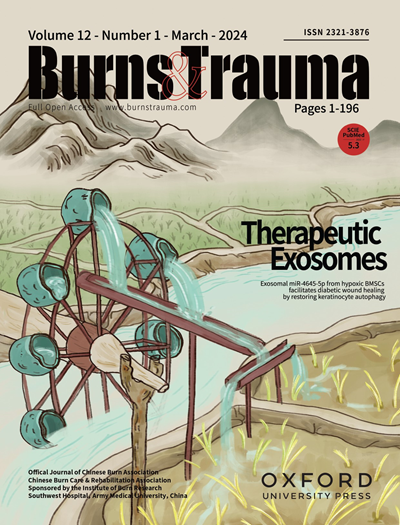PPARs介导的糖尿病伤口愈合通过Sonic Hedgehog信号调节内皮细胞线粒体功能
IF 9.6
1区 医学
Q1 DERMATOLOGY
引用次数: 0
摘要
糖尿病足溃疡(DFU)是一种常见的糖尿病并发症,通常导致伤口愈合延迟。过氧化物酶体增殖激活受体(PPARs)在调节细胞代谢和促进血管生成中起着至关重要的作用。然而,PPARs激活促进伤口愈合的机制,特别是在糖尿病疾病中,仍然没有得到充分的了解。方法利用GEO数据库对DFU创面与正常皮肤组织的差异表达基因进行鉴定。通过qRT-PCR、免疫荧光和western blotting验证PPARs在DFU新生血管中的表达。在体内,用PPARs激动剂(Chiglitazar)治疗的糖尿病小鼠进行了伤口愈合评估,包括胶原沉积和血管生成。在体外,采用高糖诱导的内皮细胞模型来评估PPARs激活对细胞迁移、管形成和线粒体功能的影响。我们进行了全转录组测序和线粒体分析,以探索潜在的机制,特别是SHH -线粒体轴。结果PPARs在DFU组织中的表达显著下调(p < 0.05),而PPARs在糖尿病小鼠中的激活促进了创面愈合、胶原沉积、肉芽组织增殖和血管生成(p < 0.05)。在体外,PPAR激活可以保护内皮细胞,促进VEGF-A和CD31的表达,减少细胞凋亡,增强细胞迁移和小管形成(p < 0.05)。在机制上,ppar通过SHH信号通路激活线粒体氧化磷酸化(OXPHOS)和膜功能。SHH基因沉默逆转了PPARs激活对线粒体功能和血管生成的影响。结论PPARs信号在DFU愈合中起关键作用,其抑制与血管功能障碍有关。激活PPARs/SHH -线粒体轴可显著增强内皮细胞代谢和血管生成。该研究为糖尿病伤口愈合的分子机制提供了见解,并支持PPARs激动剂治疗DFU的临床潜力。本文章由计算机程序翻译,如有差异,请以英文原文为准。
PPARs Mediated Diabetic Wound Healing Regulates Endothelial Cells Mitochondrial Function via Sonic Hedgehog Signaling
Background Diabetic foot ulcer (DFU) is a common and debilitating complication of diabetes, often leading to delayed wound healing. The peroxisome proliferator-activated receptors (PPARs) play a crucial role in regulating cellular metabolism and promoting angiogenesis. However, the mechanisms by which PPARs activation enhances wound healing, particularly in diabetic conditions, remain insufficiently understood. Methods Differentially expressed genes in DFU wounds and normal skin tissues were identified using the GEO database. PPARs expression in DFU neovascularization was validated by qRT-PCR, immunofluorescence, and western blotting. In vivo, diabetic mice treated with PPARs agonists (Chiglitazar) underwent wound healing assessment, including collagen deposition and angiogenesis. In vitro, high-glucose-induced endothelial cell models were used to evaluate PPARs activation effects on cell migration, tube formation, and mitochondrial function. Whole transcriptome sequencing and mitochondrial analysis were performed to explore the underlying mechanisms, particularly the sonic hedgehog (SHH) -mitochondrial axis. Results PPARs expression was significantly downregulated in DFU tissues (p < 0.05), and PPARs activation in diabetic mice enhanced wound healing, collagen deposition, granulation tissue proliferation, and angiogenesis (p < 0.05). In vitro, PPAR activation protected endothelial cells, promoting VEGF-A and CD31 expression, reducing apoptosis, and enhancing cell migration and tube formation (p < 0.05). Mechanistically, PPARs activated mitochondrial oxidative phosphorylation (OXPHOS) and membrane function through the SHH signaling pathway. SHH gene silencing reversed the effects of PPARs activation on mitochondrial function and angiogenesis. Conclusions PPARs signaling plays a critical role in DFU healing, with its inhibition linked to vascular dysfunction. Activation of the PPARs/SHH -mitochondrial axis significantly enhances endothelial cell metabolism and angiogenesis. This study provides insights into the molecular mechanisms of diabetic wound healing and supports the clinical potential of PPARs agonists for DFU treatment.
求助全文
通过发布文献求助,成功后即可免费获取论文全文。
去求助
来源期刊

Burns & Trauma
医学-皮肤病学
CiteScore
8.40
自引率
9.40%
发文量
186
审稿时长
6 weeks
期刊介绍:
The first open access journal in the field of burns and trauma injury in the Asia-Pacific region, Burns & Trauma publishes the latest developments in basic, clinical and translational research in the field. With a special focus on prevention, clinical treatment and basic research, the journal welcomes submissions in various aspects of biomaterials, tissue engineering, stem cells, critical care, immunobiology, skin transplantation, and the prevention and regeneration of burns and trauma injuries. With an expert Editorial Board and a team of dedicated scientific editors, the journal enjoys a large readership and is supported by Southwest Hospital, which covers authors'' article processing charges.
 求助内容:
求助内容: 应助结果提醒方式:
应助结果提醒方式:


